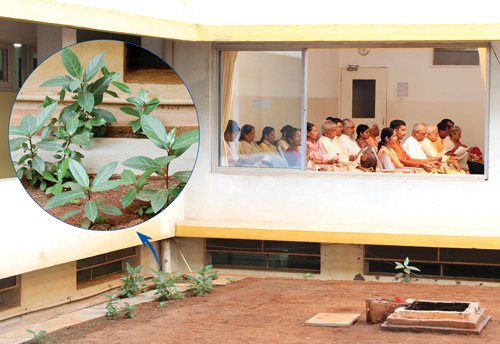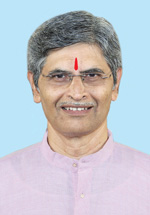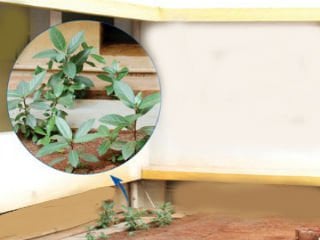
Ever since chanting of the Dattamala mantrajapa has commenced in the Sanatan ashram, 58 saplings of the cluster fig tree have sprung in its surroundings. Yogatadnya Dadaji Vaishampayan says that these are an indicator of a protective sheild being formed around Paratpar Guru (Dr.) Athavale.
‘Since September 2015 at Sanatan’s ashram in Ramnathi in Goa, 20 seekers have been chanting the ‘Dattamala mantrajapa’ aloud for an hour and a half each in the morning and evening session every day. Ever since this chanting has commenced, 58 saplings of the cluster fig tree have sprung in the open space at a short distance from the yadnyakund. When Yogatadnya Dadaji Vaishanpayan was apprised about this with pictures, He said that He was delighted to hear this because it indicates that a protective shield has been formed around Paratpar Guru (Dr.) Athavale.’
– Mr. Atul Pawar, Nasik
Science underlying growth of plants of
the cluster fig tree in the surroundings of Sanatan
ashram at Ramnathi after loud chanting of the Dattamala
mantrajapa, as mentioned by Yogatadnya Dadaji Vaishanpayan

God is the creator of living and non-living beings. Man, animals, birds and vegetation are closely associated with each other. In the ancient times Sages would live in the forest and knew the importance of plants, flowers and trees. In order to improve the health of human beings and to alleviate diseases they discovered several types of medicinal plants in the forest.
Of some trees are labelled as Divine trees in Bharatiya culture and one of them is the cluster fig tree. Several ancient Holy texts say that Trimurti (Trinity of Deities) reside in this tree – Brahma in the root, Vishnu in the mid-trunk and Shiva in front because of which its worship is recommended.

These trees release great amounts of oxygen into the atmosphere because of which balance of the ecosystem is maintained. As per Ayurveda too this tree is extremely important due to its medicinal qualities. Let us try to understand the scientific and spiritual reasons for these Divine trees growing automatically in the premises of Sanatan ashram in abundance.
Based on the guidance of Yogatadnya Dadaji Vaishampayan, as soon as the chanting of the mantrajapa in the Sanatan ashram in Ramnathi commenced, 58 saplings of the cluster fig tree sprung spontaneously in the area adjoining the yadnyakund besides the meditation room. This proves that chanting of mantras make the environment Sattva predominant and positive changes get trigged in the nature based on the Divine Principle present within the mantra. Changes in nature in the surroundings of the ashram and spiritual experiences of a seeker after chanting of the Dattamala mantrajapa for two months are given further.
Brief introduction of the compiler
1. Dr. Ajay Ganpatrao Joshi has worked as Executive Office in the organization named BAIF in Pune for 16 years. He has also served as Production Manager at Ventri Biologics for another 16 years. Presently he is rendering fulltime seva in the Holy texts section of Sanatan’s Ramnathi ashram.
2. Dr. Pramod Martand Ghole obtained his degree of B.Sc. (Agriculture) from Pune and M,Sc. and Ph.D. degrees in Agricultural Entomology from Delhi’s Indian Agricultural Research Institute. He has an experience of working in NABARD (National Bank For Agruicultural And Rural Development) for 30 years and is presently designated as Chief General Manager of its Chandigarh branch.
1. Natural changes occurring in the premises
of the ashram after chanting of the Dattamala mantrajapa
Within just 30 days after commencing chanting of the Dattamala mantrajapa in the meditation room of the ashram, 58 plants of the cluster fig tree growing spontaneously in the area adjoining the yadnyakund
Since past two months, chanting of the Dattamala mantrajapa is being done. A yadnyakund is situated in an area of 9×9 meters near the window of the meditation room located in the southern direction. On all four sides of the yadnyakund is the foundation of the building of the ashram. Within approximately 30 days of commencement of the Dattamala mantrajapa, approximately 58 plants of 15 centimetre height of the cluster fig plant, sprung spontaneously in the vicinity of the yadnyakund.
2. Probable causes for plants growing in any spot
2A. Growth of plants after sowing seeds and planting sappling
A plant can grow in the soil after sowing seeds of that plant or after planting a sappling of that plant.
2B. Plants arising due to naturaly effects
Plants can arise from seeds sown in the soil from droppings of birds or through the wind or water.
2C. Plants growing due to Chaitanya (Divine consciousness) within the premises
Some trees are believed to be extremely sacred Divine trees. The vad (Banyan), pipal (Holy fig) and cluster fig trees are included in this category. These arise spontaneously without any physical cause in sacred premises, for example the cluster fig tree at Narsobawadi, the nandurki /pipal (Holy fig) tree at Dehu. Their mission is to emit Divine consciousness.
3. Reasons other than 2A and 2B for
appearance of cluster fig plants in the ashram surroundings
3A. Based on point 2A, the cluster fig tree is never planted.
(Reference : http://www.sciencebehindindianculture.in/some-trees-are-considered-sacred-why/)
3B. Cluster fig trees in the ashram have not borne any fruit and plants
in such large numbers cannot arise from seeds sown through the droppings of birds
Based on point 2B, formerly there was not a single cluster fig tree outside the ashram building and near the tarred road nearby. Post completion of construction of ashram, since 2009, small plants of the cluster fig tree started appearing in its premises. They have now grown to 3 to 4 metres tall but are still not bearing any fruit. Besides it is impossible for such tall trees to arise from planting of seeds into the soil through droppings of birds because the yadnyakund is surrounded on all four sides by three storeys of the ashram building where birds never venture. What is more unique is that near the meditation room, at a distance of 1 to 2 metres from the yadnyakund, the plants have arisen close to each other in abundance. Thus they are an indicator of flow of Divine consciousness.
4. Due to emission of Sattva predominant vibrtaions
from the mantrajapa cluster fig plants have sprung in abundance
In the June 2000 issue of the monthly magazine Manashakti, following points have been mentioned in the article on ‘Parashakti and trees’.
Dr. Grand says perhaps some radiant energy or inspiration arises from the physical body of man which has an effect on animals and trees. Let us refer to this as the subtle mind or Parashakti. Experts say from this research that after passage of time the effect of mental energy, thought projection, prayer and music on plants can be predicted.
Based on this opinion it can be said that ever since chanting of the Dattamala mantrajapa has commenced in the meditataion room of the ashram due to emission of Sattva predominant vibrations from the mantrajapa many cluster fig plants have arisen here.
5. As Banyan, Holy fig, chafa
(Frangipani),Holy basil, bel (Indian quince),
shami (Indian mesquite), tamarind, parijat (Night-
flowering jasmine) and cluster fig trees release oxygen into
the atmosphere for 24 hours they are referred to as Divine trees.
Banyan, Holy fig, Frangipani, Holy basil, Indian quince, Indian mesquite, tamarind, night-flowering jasmine and cluster fig trees release oxygen, essential for living organisms for their survival, throughout 24 hours, whereas other plants emit toxic gases such as carbon dioxide and carbon monoxide into the atmposphere. That is precisely why Banyan, Holy fig, Frangipani, Holy basil, Indian quince, Indian mesquite, tamarind, night-flowering jasmine and cluster fig trees have been referred to as Divine trees since ancient times. The rest are referred to merely as trees or plants as proven scientifically.
(Reference : Vishwachaitanyache vidnyan)
6. Perceiving that many cluster fig
plants have sprung in the ashram to provide
physical, psychological and spiritual benefit to the seekers
A study of radiation of energy rays from trees has been done by Bowis. Further, Simonton measured the wavelengths of eatables in various states. From this research it was concluded that that plants possess the capacity to increase the energy waves of humans, resulting in an improvement in their physical and mental health. (Reference : Manashakti June 2000)
To relieve seekers of physical distress such as exhaustion and bodyache and distress at the psychological and spiritual levels approximately within one month 58 cluster fig plants sprung up in the vicinity of the yadnyakund.
7. Since these plants possess a special ability
to absorb subtle vibrations and frequencies they multiply
more in sattvik places as proved by various scientific experiments
Mr. Jagdishchandra Bose was the first scientist to study the effects of very subtle frequencies on tissues of plants and the changes occurring in the potential of their cell membranes. He put forth various theories such as plants too have emotions, they can feel pain, they can develop love etc. (Reference : en.wikipedia.org/wiki/Jagdish_Chandra_ Bose.)
The points above make it clear that the plants are very sensitive in the context of the external environment and that through their sensations they have the ability to perceive subtle vibrations and frequencies and to absorb them as well. As advised by Yogatadnya Dadaji Vaishampayan chanting of Dattamala mantrajapa has commenced since past 2 months in the ashram’s meditation room. Above points could be the reason behind spontaneous growth of approximately 58 plants of the cluster fig tree 15 centimetre in length near the southern window of the meditation room in the area measuring 9×9 meters around the yadnyakund, within 30 days of commencing the chanting.
8. Spiritiual experiences of a seeker chanting the Dattamala
mantrajapa for two months and the seekers visiting the ashram
Incidents beyond the comprehension of the intellect such as fresh foliage arising from dry twigs when Sages were performing austerities or rounds of chanting are recorded in several Purans. Spirituality is a science. Hence as per he spiritual principle of ‘God is present where there is spiritual emotion’, through the Five Cosmic Principles creation of living and non-living organisms occurs and spiritual experiences of such other concepts as experienced in the Puranic period can be experienced in Kaliyug as well. But for that spiritual practice has to be performed with the objective of God-realisation. God always gives such spiritual experiences to seekers from different sects and to Sanatan’s seekers.
8A. Deriving Divine consciousness through the mantrajapa
H.H. Gurudev says that that through this mantrajapa, Divine consciousness spreads to society. I perceived that as told by Him, this mantrajapa is truly endowing Divine consciousness.
8B. Not feeling sleepy or drowsy during the chanting
Generaly when I chant I feel sleepy or drowsy but when chanting the Dattamala mantrajapa this does not happen, it occurs continuously with concentration. – A seeker
8C. When spiritually curious people visit the ashram,
they feel pleasant on hearing this Dattamala mantrajapa chanting
Guests visiting the ashram happen to enter the meditation room when chanting of the mantrajapa is in progress and they feel like listening to it with concentration and peaceful mind. They also feel pleasant after listening to it. These are the spiritual experiences given by several spiritual aspirants visiting the ashram.
– Dr. Ajay Joshi, Sanatan ashram, Ramnathi, Goa and Dr. Pramod Ghole, Chief General Manager, NABARD, Chandigarh (15.11.2015)
Appeal to experts in botany, researchers,
students and those with a scientific bent of mind
As told by Yogatadnya Dadaji Vaishampayan when performing Dattamala mantrajapa in Sanatan’s ashram in Ramnathi, Goa natural changes are occurring in the surroundings of the ashram.
1. After commencing Dattamala mantrajapa in the ashram what is the scientific reason for growth of cluster fig plants?
2. Why have only cluster fig plants grown here? Why have other plants not sprung?
3. Adjoining the yadnyakund outside the meditation room 58 cluster fig plants have sprung spontaneously after chanting of the Dattamala mantrajapa commenced in the mediatation room. Why did these plants not appear elsewhere in the ashram? What changes occurred in the atmosphere or soil in the area adjoining the yadnyakund for these plants to arise there?
4. Which scientific instruments should be used to conduct research on these cluster fig plants? We will be grateful if scientific researchers assist us in this.
– Administrator, Sanatan ashram, Ramnathi, Goa
(Contact : Mr. Rupesh Redkar, e-mail : [email protected])

 Unintelligible changes in Varanasi Ashram
Unintelligible changes in Varanasi Ashram Analysis of presence of several Deities in the meditation room of Sanatan’s ashram in Ramnathi...
Analysis of presence of several Deities in the meditation room of Sanatan’s ashram in Ramnathi... Divine changes that indicate increasing sattvikata in the Ashram
Divine changes that indicate increasing sattvikata in the Ashram Providing direction on establishing the ‘Hindu Nation’
Providing direction on establishing the ‘Hindu Nation’ Environment conducive to spiritual progress
Environment conducive to spiritual progress Objective of spiritual practice in every act
Objective of spiritual practice in every act